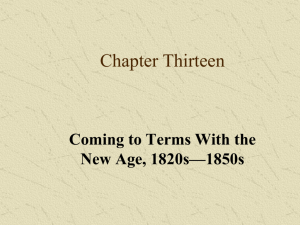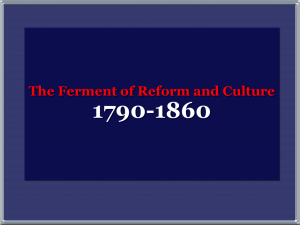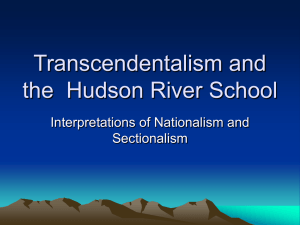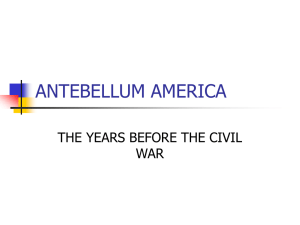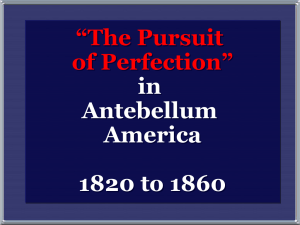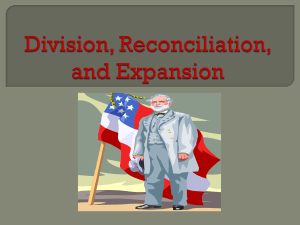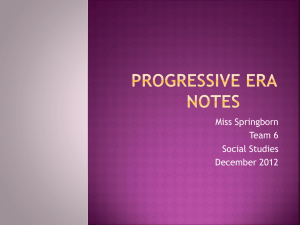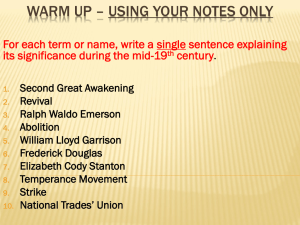Chapter 14 Study Guide
advertisement
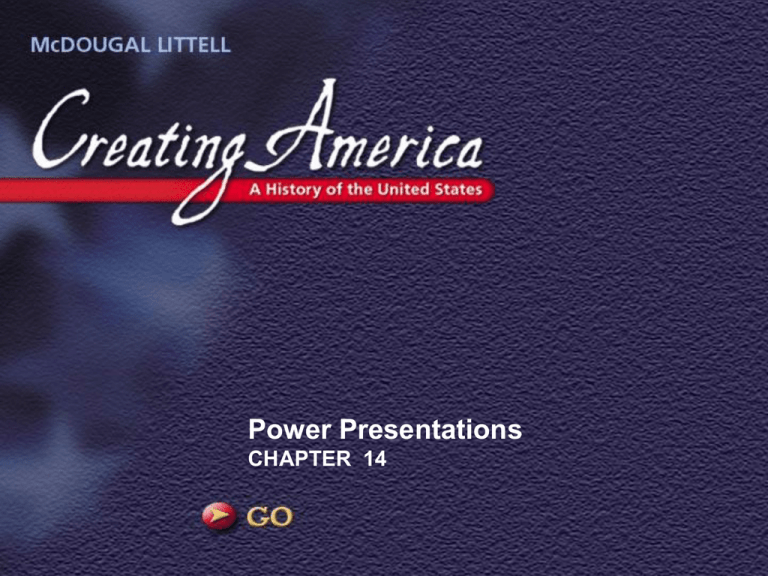
Power Presentations CHAPTER 14 Impact of the Individual Image You are a writer who moves to New York in the mid1800s. A newspaper hires you to write about reform. One day, you hear a speaker call for the end of slavery. Another day you talk to a factory worker whose pay has been cut. In the city, you see great poverty and suffering. What reforms do you think will most benefit American society? • How might you persuade Americans to change life in the city? • Should reform come about through new laws or through individual actions? 1828 Noah Webster publishes the American Dictionary of the English Language. 1829 David Walker prints Appeal, a pamphlet urging slaves to revolt. 1836 The Lowell Mill girls go on strike to demand better conditions. Image 1843 Dorthea Dix asks the Massachusetts legislature to improve the care of the mentally ill. 1848 The Seneca Falls Convention demands women’s rights. To World 1851 Maine passes a law banning the sale of alcohol. 1824 The British Parliament makes trade unions illegal. 1829 Louis Braille invents a raised type that allows blind people to read. 1845 Ireland’s potato crop fails, causing famine. Thousands flee to America. 1848 A revolution in Germany fails. Some Germans move to America. 1854 Brazil’s first railway opens. Back to U.S. Back to Home Main Idea In the mid-1800s, millions of Europeans came to the United States hoping to build a better life. Why It Matters Now These Germans, Irish, and Scandinavians had a strong influence on American culture. Map What groups of immigrants came to the United States in the mid-1800s? Where did they settle? How did they influence the United States? settled in port cities Immigration Scandinavians Irish Germans settled on farms in the northern Midwest Influences: labor and political activity settled in cities and farms on the frontier Influences: kindergartens, gymnasiums, musical groups, and food • What were the push-pull factors that led to immigration? • How did the arrival of so many immigrants affect U.S. cities? • What was the Know-Nothing Party, and what was its point of view about immigration? Analyzing Causes How did the rapid increase in immigration cause conflict? Think About • why Irish immigrants and free blacks competed for jobs • the growth of cities and the problems it created • the prejudices of nativists • religious differences Back to Home Main Idea Inspired by nature and democratic ideals, writers and artists produced some of America’s greatest works. Why It Matters Now Nineteenth-century writers such as Hawthorne and Thoreau laid the foundation for American literature. Who were important writers and artists in the nineteenthcentury U.S.? What works did they produce? WRITER OR ARTIST HIS OR HER WORK Washington Irving “Rip Van Winkle” James Fenimore Cooper The Last of the Mohicans Henry David Thoreau Walden Walt Whitman Leaves of Grass Emily Dickinson 1775 poems Nathaniel Hawthorne The Scarlet Letter Herman Melville Moby Dick Image • What was romanticism and how did Americans adapt it? • What is civil disobedience and what did Thoreau do that is an example of it? • How did the writers of the mid-1800s shape modern literature? Evaluating Why do you think the literature and art of the mid-1800s are still valued? Think About • the way they feature U.S. history and culture • their universal themes—themes that relate to all people in all time periods • the way they reflect changes happening at that time Back to Home Main Idea In the mid-1800s, several reform movements worked to improve American education and society. Why It Matters Now Several laws and institutions, such as public schools, date back to this period. What were the problems identified by reformers of the mid-1800s? What were their solutions? PROBLEM REFORMER’S SOLUTION poverty caused by drinking laws that ban alcohol unsafe work for little pay and long hours strike lack of education public schools and new colleges mentally ill in jail hospitals unorganized prisons children in special jails and prisoner rehabilitation • How did the Second Great Awakening influence the reform movement? • How did labor unions try to force business owners to improve working conditions? • What were women’s contributions to the reform movement? Recognizing Effects What was the long-term impact of the reform movement that took place in the mid-1800s? Think About • the changes reformers made in education, temperance, prisons, and the care of the disabled • which of those changes are still in effect today Back to Home Main Idea The spread of democracy led to calls for freedom for slaves and more rights for women. Why It Matters Now The abolitionists and women reformers of this time inspired 20th-century reformers. What historical developments in the abolition movement occurred between 1807 and 1865? 1807 Congress outlaws importation of slaves. 1831 Garrison publishes The Liberator. 1841 The slaves of the Amistad win their freedom. 1845 Douglass publishes his autobiography. 1849 Tubman escapes and begins working on the Underground Railroad. 1865 The government abolishes slavery Map Image • Why were freedom of speech and freedom of the press important to the abolitionist movement? • What were Frederick Douglass’s contributions to the abolitionist movement? • What were Elizabeth Cady Stanton’s contributions to the women’s rights movement? Drawing Conclusions Why do you think that many of the people who fought for abolition also fought for women’s rights? Think About • why they opposed slavery • the social and economic position of women • what the two causes had in common Back to Home REVIEW QUESTIONS ANSWERS: READ AND TAKE NOTES 1 What factors influenced so many immigrants to come to America in the 1800s? 2 What did Germans contribute to U.S. culture? 3 How did the potato famine affect Irish emigration? 4 How did American artists display the love of nature in their paintings? 5 What did the Transcendentalists believe? 6 Why did many business owners support the temperance movement? 7 Why was it hard for African Americans to receive an education? 8 Who published antislavery writings? 9 How did the Underground Railroad work? 10 What was the Seneca Falls Declaration of Sentiments and Resolutions? HOW PEOPLE INFLUENCED AMERICA IN THE MID-1800s. Immigrants Germans—kindergarten, gymnasiums, some foods; Irish—city politics Writers Thoreau—civil disobedience; Whitman and Dickinson—modern poetry; Poe—horror and detective fiction Reformers revivalists—reform; temperance workers—ban on alcohol; Mann—public education; Dix—treatment of the mentally ill Abolitionists Walker, Garrison, Douglass, Truth, Grimkés—convinced many that slavery was wrong Women Stanton, Mott, Truth, Anthony—persuaded some that women deserved equal rights Back to Home These labels let you know where you are in the presentation. When you click on the arrow you will be linked to a related visual. Map Image These buttons link you to special areas. Use these buttons to go back to the previous slide, or to move forward in the presentation. To reveal the content of a slide just press the space bar or click your mouse once. To use a button, move your pointer over the button. When your pointer becomes a hand, click your mouse. Back to Previous
